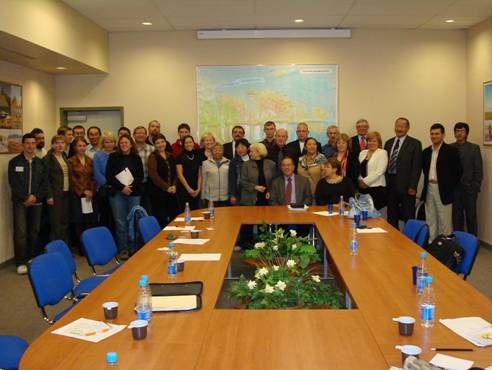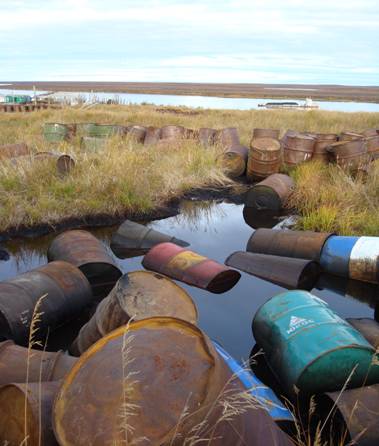Collaboration and Partnerships
Note: EPA no longer updates this information, but it may be useful as a reference or resource.
Community-Based Abandoned Drum Clean Up and Chukotka
Demonstration Project
EPA Region 10 - Seattle - Office of Ecosystems, Tribal, and Public Affairs, Tribal Unit,
US EPA Office of International Affairs
Geographic location/description: Sand Point, Alaska and the Russian Indigenous Villages of Lavrentiya, Lorino, and Khanchelan, Chukotka Autonomous District
The Alaska Village of Sand Point is located on Popof Island, along the Shumagin islands, 570 air miles from any road system. It is accessible only by boat or bush plane. The islands are known for their isolation, violent storms, and harsh winters. Volcanoes frequently erupt along the rugged terrain. These are the most active volcanoes in North America. Sand Point is a breeding ground to migratory birds from around the world, and is a stronghold to the endangered Stellar Sea Lion. A community cut off from the rest of the world, Sand Point has challenges in getting fuel and supplies, and residents must endure harsh living conditions and inadequate solid waste and sewage systems on a day-to-day basis.
Description of activity: The rich marine ecosystem of the Bering Sea separates the United States and Russia, but the two countries share a common concern for its health and resources. Indigenous communities on both sides depend upon the Bering Sea for subsistence. Since conditions are so similar in these coastal villages, Sand Point is an excellent drum clean up model for other isolated Alaskan communities, and in Russia.
As a result of local activities, drums containing hazardous materials accumulated on Popof island for several years. Once hazardous materials accumulated in Sand Point, it is was difficult to transport them off the island. The drum site was a disaster of over 600 corroded drums and spilled product pooling inside leaky burms. A local stream used as a traditional source of drinking water flows nearby, and the site slopes down to a beach used for gathering subsistence foods.
With funding from EPA, 3 Tribes in Sand Point, a Regional Nonprofit organization, City, State, and Federal government collaborated to clean up the abandoned drum site. An MOU helped to locally define the common goal and approach. A Quality Assurance Plan was approved by EPA and the State of Alaska to guide sampling and analysis.
Eighteen local laborers in Sand Point were HAZWOP certified, and most assisted in clean up operations on site. 608 drums in Sand Point were categorized and cleaned up. The material (used oil) was transferred into 6 large holding tanks. The contents of 35 drums need further analysis and will be shipped out of Sand Point as weather improves this Summer. Site access has been limited with fencing and signage, preventing further damage to the watershed and beach.
The Sand Point project has inspired other Alaska Tribes to do drum clean up. The education and outreach model has been a stepping stone for the Russian indigenous communities of Lavrentiya, Lorino, and Khanchelan to implement local environmental health assessments and begin clean up.
A US delegation to Russia met with Russian Officials in Anadyr, Russia, September 2007, and signed an Accord to collaborate in 2008 for the 3 model indigenous village drum clean ups in Chukotka. During this visit, a workshop was conducted for participants from 16 Russian indigenous communities to share lessons learned during the Sand Point clean up. Participants gained skills in developing community-based awareness and stewardship to address health and environmental concerns, and apply safe practices for identifying, sampling, handling, labeling, and storing drums of discarded hazardous materials to prepare for recycling or removal. A documentary, “Chukotka Drums,” was developed and will be featured at the 2008 Alaska Forum on the Environment’s Film Festival. Planning is currently underway for an Alaska Statewide Tribal workshop in April 2008 on community-based approaches to cleaning up local drums. This training will include Russian participants, who plan to tour the Sand Point site. EPA and State of Alaska are doing concurrent planning for addressing more Alaska village drum clean up sites.

U.S. and Russian government representatives meet in Anadyr, Russia to discuss
Abandoned Drum issues affecting the human health and the environment.
The State of Alaska Department of Conservation contributed considerable resources in the oversight, operations, and clean up of the Sand Point site. EPA Arctic Monitoring Assessment Program and EPA Indian General Assistance Program provided funding to: train key local residents in communities, conduct local health and environmental assessments, educate on proper planning, inventory, and clean up local drum sites. The grantees were able to document their efforts and develop lessons learned to share with others.
Capacity building and outreach efforts, planning, and implementation of this project have improved environmental results by removing drums from the tundra both in Alaska and Russia. The project represents a unique approach to getting things done by instilling community ownership and education to create awareness and change behavior. The project is sustainable because it creates a sense of local empowerment by matching indigenous communities together, and facilitating an exchange in addressing similar problems using a community-based approach.
Interagency partners: US State Department; Alaska Department of Conservation (key partner, contributing considerable resources in the oversight, operations and clean up of the Sand Point site)
Local partners: 3 Tribes in Sand Point (Unga Tribal Council, Pauloff Harbor Tribe, and Qagan Tayagungin Tribe), a Nonprofit organization (Aleutian Pribilof Islands Association), 16 Russian indigenous Tribes (including 3 model villages), and a municipality (City of Sand Point).

Drum Site in Chukotka, Russia
![[logo] US EPA](../gif/logo_epaseal.gif)